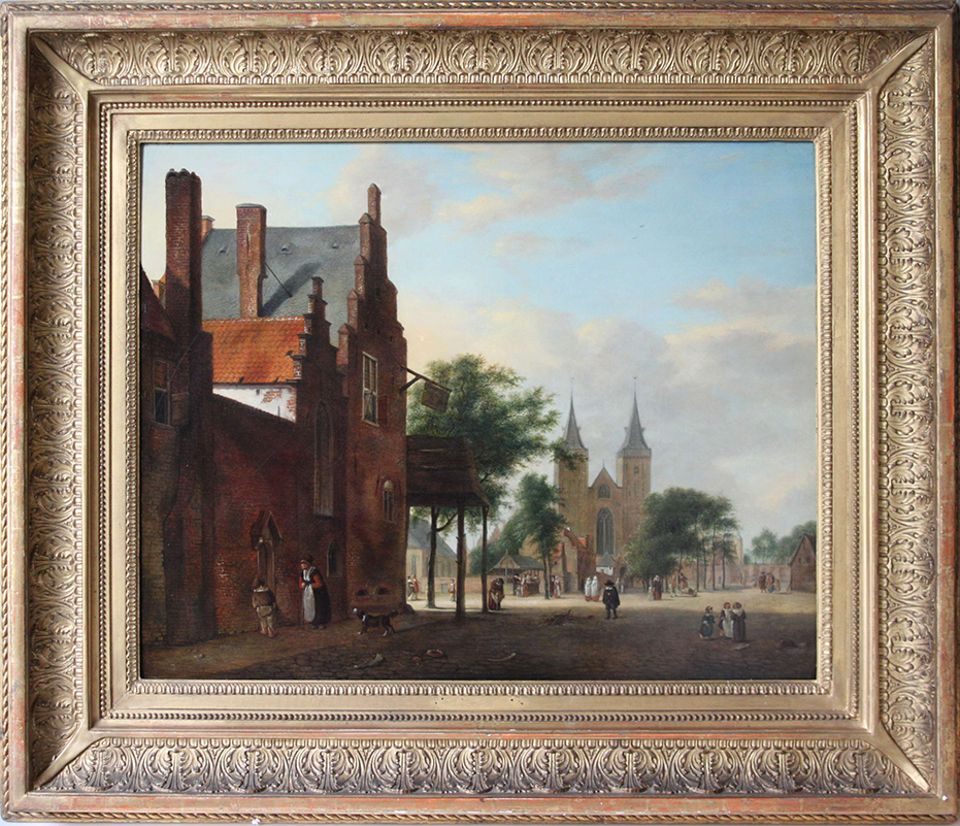News:
German Cathedral Returns Nazi-Looted Old Master Painting
The Commission for Looted Art in Europe (CLAE), representing the heirs of Gottlieb and Mathilde Kraus, and the Verein zur Erhaltung des Xantener Domes e.V. (Association for the Preservation of the Xanten Cathedral), Germany, are pleased to announce the return of the painting ‘View of a Dutch square’ attributed to the Dutch 17th century painter Jan van der Heyden, to the heirs of Gottlieb and Mathilde Kraus, who fled Vienna in April 1938 to escape from Nazi persecution.
 ‘View of a Dutch square’ attributed to the Dutch 17th century painter Jan van der Heyden finally returns to the heirs of Gottlieb and Mathilde Kraus
‘View of a Dutch square’ attributed to the Dutch 17th century painter Jan van der Heyden finally returns to the heirs of Gottlieb and Mathilde Kraus
Gottlieb Kraus (1867-1952) was a businessman and honorary consul for Czechoslovakia in Austria. Beginning in the early years of the 20th century, he and his wife Mathilde (1873-1954) assembled a notable art collection of over 160 paintings, and in 1923 their apartment at Vienna IV, Wohllebengasse 16/5 was opened as a museum so that it could be publicly displayed. The collection included the painting ‘View of a Dutch Square’ attributed to the Dutch Old Master, Jan van der Heyden.
Following the so-called ‘Anschluss’ with Germany in March 1938 and the persecution of the Jews by the Nazis, Gottlieb and Mathilde Kraus fled via Prague to the USA, leaving their entire art collection behind in Vienna. On 13 June 1941 all their property, including the art collection, was confiscated by the Gestapo. On 8 July 1942 the Van der Heyden painting was sold by the Gestapo to Heinrich Hoffmann, Hitler’s friend and photographer, and father-in-law of Baldur von Schirach, the Nazi Governor of Vienna.
In May 1945 the Hoffmann art collection was found by Allied officers at Schloss Dietramzell, Bavaria, and sent to Munich where it was inventoried and photographed. In March 1959 the Van der Heyden painting and other paintings were transferred by the Allies to the State of Bavaria with specific reference to the restitution obligation. The Van der Heyden painting subsequently entered the Bavarian State Paintings Collections in Munich as inventory no. 12891.
After the war the Kraus family made efforts over many decades with the governments of both Germany and Austria to find and recover their art collection, but without success.
Of the family’s over 160 seized paintings, the Van der Heyden is only the seventh painting to be recovered by the family since 1945, the previous six being returned by Austria in 2002 and 2004.
When researching the paintings, the Commission for Looted Art in Europe discovered that in March 1962, the Van der Heyden painting had been handed over by the State of Bavaria to Mrs Henriette Hoffmann-von Schirach, daughter of Heinrich Hoffmann, as a ‘return sale’ (Rückkauf). This led to the discovery that many paintings and other cultural items were secretly returned by Bavaria to families of high-ranking Nazis over a period of some 20 years after the war. This remarkable scandal has been the subject of an investigation in the Bavarian Parliament, leading to a report by the Bavarian Culture Minister. An in depth German-government funded investigation is to be published shortly.
The Van der Heyden was returned to Mrs Hoffmann-von Schirach in March 1962 in exchange for the sum of 300 DM.
On 14 November 1963, Mrs Hoffmann von Schirach sold the painting through the Lempertz auction house in Cologne for 16,100DM. The Dombauverein Xanten in North Rhine-Westphalia bought the painting at Lempertz without knowledge of the fact that the painting had previously belonged to the Kraus family. The painting depicts St Victor, the cathedral church of Xanten, and has hung in the Cathedral chapter house which houses the Cathedral Association since 1963.
In 2011 a restitution claim for the painting was submitted to Xanten by the Commission for Looted Art in Europe on behalf of the Kraus family
Following the recent agreement, the Dombauverein Xanten is now returning the Van der Heyden painting to the Kraus heirs in recognition of its expropriation from Gottlieb and Mathilde Kraus as a result of Nazi persecution of the Jews.
John Graykowski., great-grandson of Gottlieb and Mathilde Kraus, said, "I hope that this will serve as an example to other institutions and individuals who have paintings and other artwork with similar provenance, that it is never too late grant a measure of justice and compassion.”
Anne Webber, Co-Chair of the Commission for Looted Art in Europe, said: “Almost 75 years after the end of the war, and even in such a clear-cut case as this, there is in Germany still no obligation to return Nazi looted art, despite many statements of intent from the German authorities. We appreciate that the Xanten Dombauverein has finally taken the decision to return this painting to the Kraus family, and hope that it will set an example to other institutions and foundations in Germany.
The story of this painting is particularly shocking, having passed, after seizure in Vienna in 1941, through the hands of the leading Nazis into one of their private collections. Found by the Allies and handed over to Bavaria after the war for the purpose of restitution, it was instead returned by Bavaria not to the rightful owners but to the leading Nazi family in whose possession it had been found.
Today, almost 80 years since the painting was seized by the Nazis in Vienna, and 70 years since the Kraus family began their efforts to recover their looted works of art, it is very moving that this painting is finally returning to the family. We very much hope that the many other missing paintings from the family’s collection, particularly the Nicolaes Berchem landscape, also handed over to Mrs Hoffmann-von Schirach by Bavaria in 1960, will soon return to them.”


